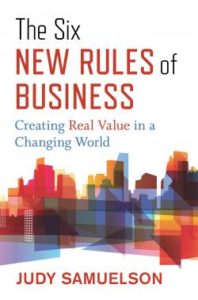
“Tell me which of the pressing issues of our time keep you awake at night, and I will tell you how the old rules of profit maximization and short-term thinking contribute to those problems,” Judy Samuelson writes in the introduction to her new book, The Six New Rules of Business: Creating Real Value in a Changing World.
The rules are changing. The COVID-19 pandemic and other recent crises have made it clear that business and society are more intertwined than ever before, and the old notions of “what is good for business” are no longer sustainable for society – or for business itself.
Business, Samuelson argues, is the most influential institution in today’s world and has the resources and capacity, as well as the global reach, to address systemic challenges from climate change to inequality. At the same time, the Milton Friedman worldview of profit maximization and shareholder primacy is losing ground as businesses today confront reputational risk and challenges to their business model from increasingly complex global supply chains, employee activism, external pressures and environmental impacts, all made more visible than ever by the transparency power of the internet.
In a rapidly changing world, the old rules that governed business for much of the 20th century are no longer fit for purpose.
Instead, Samuelson has compiled six new rules, now emerging from boardrooms and business schools, that consider new sources of value creation derived from new definitions of corporate purpose. The first six chapters of the book each examine one of the new rules, presented alongside the outdated thinking it’s intended to replace. These rules are:
OLD Rule: Hard assets determine firm value.
NEW Rule: Reputation, trust, and other intangibles drive business value.
OLD Rule: “Shareholder value” or “profit maximization” is the organizing principle of the corporation.
NEW Rule: Businesses serve many objectives beyond shareholder value.
OLD Rule: Corporate responsibility is defined by host communities and fence-line neighbors.
NEW Rule: Corporate responsibility is defined far outside the business gates.
OLD Rule: Labor is a cost to be minimized.
NEW Rule: Employees give voice to risk and competitive advantage.
OLD Rule: Capital is king; shareholders rule.
NEW Rule: Culture is king; talent rules.
OLD Rule: Compete to win.
New Rule: Co-create to win.
Underpinning all of these new rules is the idea that business and society are inextricably linked. The walls between business and society that allowed companies to ignore their effect on the world around them while maintaining an outsized influence over it are collapsing, as business leaders are forced to contend with externalities that can undermine their success. The new rules ask businesses to consider stakeholders beyond their shareholders, to recognize intangible forms of value and to hold themselves accountable for their impact on society. They call for moving the focus beyond short-term profit, to long-term risks and opportunities that impact not only society but the future of business itself.
The final two chapters look to the path ahead. Samuelson argues that current executive pay and incentive structures perpetuate the shareholder primacy mindset at the cost of both employees and long-term value creation. She also examines the changes already starting to take place in business schools, where some educators are beginning to challenge long-held ideas about the purpose of business. Reforms in these areas, she contends, are key steps in confronting the status quo and creating real systems transformation.
Samuelson, the founder and executive director of the Aspen Institute Business and Society Program, draws on decades of experience to pepper the book with engaging real-world examples and case studies that illustrate the successes of businesses that have chosen to embrace the new rules, as well as the failures of businesses still clinging to the old rules. She maintains that the new rules are here to stay and that companies that cannot or will not get with the program will find themselves left behind.
For the most part, Samuelson does not break much in the way of new ground, drawing largely on changes in values and practices that are already underway among leaders in the business world, but she lays out the new rules clearly and purposefully. While some may find her level of optimism unrealistic, her tone is confident and encouraging as she issues a call to action and offers a path forward.
As Samuelson concludes, “The new rules not only are written but are producing real results – and in time to tackle the unprecedented challenges facing our world.”
